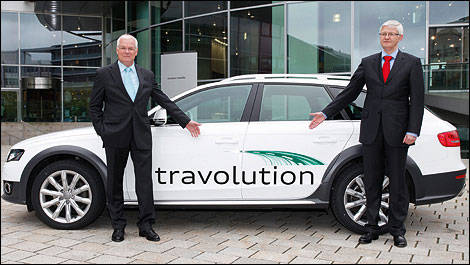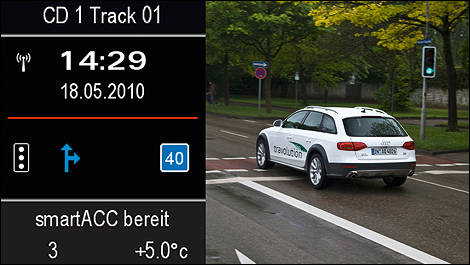As reported by Audi
Building highly efficient cars is one aspect of Audi’s ‘Vorsprung durch Technik’ – making sure that they can be used for efficient journeys is another. The development teams at Audi see the task in its entirety, and examine the complete road traffic system. Their travolution project is a concept for a dialogue between cars and traffic signals. It reduces the amount of time spent at a standstill or accelerating, and in this way cuts the vehicles’ fuel consumption. Today, journalists and traffic planners are testing travolution on demonstration runs in Ingolstadt.
The results obtained during the first travolution project in 2006 were immediate and dramatic: reduced waiting times at traffic signals cut fuel consumption by 17 percent. In a full year this would save as much as 700,000 litres (184,920.44 US gallons) of fuel. The secret of this success: the traffic signals in Ingolstadt are controlled by a new, adaptive computing algorithm that Audi developed in cooperation with partners at colleges of advanced engineering and in business and industry.
Audi has now developed travolution still further, by enabling vehicles to communicate directly with traffic light systems, using wireless LAN and UMTS links. 15 test vehicles and 25 sets of traffic lights now permit the system to be sampled in actual traffic conditions in the city on the Danube.
The traffic signals transmit data that are processed into graphic form and shown on the car’s driver information display screen. The graphics tell the driver for instance what speed to adopt so that the next traffic light changes to green before the car reaches it. This speed, which keeps the traffic flowing as smoothly as possible, can then be selected at the adaptive cruise control (ACC) – but the driver can also delegate this task to the car’s control system.
If the car is stopped at a red traffic light, this transmits information via the car’s computer on how long the driver will have to wait before it switches to green again. If on the other hand the car approaches a traffic light that is about to switch to yellow or red, the driver is warned by a visual or acoustic signal, or by a brief interruption to the flow of power from the engine.
When the car is part of a network in this way, the driver can reduce the amount of time spent at a standstill and cut fuel consumption by 0.02 of a litre for every traffic-light stop and subsequent acceleration phase that can be avoided. The potential is enormous: if this new technology were applied throughout Germany, exhaust emissions could be lowered by about two million tonnes of CO2 annually, equivalent to a reduction of approximately 15 percent in CO2 from motor vehicles in urban traffic.
The travolution system also makes it possible to pay online when refueling or parking the car. The car itself communicates with the stationary equipment at the filling station or parking garage. When the driver confirms the charge via the Multi Media Interface MMI, it is automatically debited from the customer’s account or credit card.
To demonstrate the progress that travolution development work has made, Audi has organised talks and demonstration runs for journalists and traffic planners on June 2, 2010 in Ingolstadt, with the aim of illustrating the potential offered by networking cars with the traffic infrastructure.
Building highly efficient cars is one aspect of Audi’s ‘Vorsprung durch Technik’ – making sure that they can be used for efficient journeys is another. The development teams at Audi see the task in its entirety, and examine the complete road traffic system. Their travolution project is a concept for a dialogue between cars and traffic signals. It reduces the amount of time spent at a standstill or accelerating, and in this way cuts the vehicles’ fuel consumption. Today, journalists and traffic planners are testing travolution on demonstration runs in Ingolstadt.
 |
| Photo: Audi |
The results obtained during the first travolution project in 2006 were immediate and dramatic: reduced waiting times at traffic signals cut fuel consumption by 17 percent. In a full year this would save as much as 700,000 litres (184,920.44 US gallons) of fuel. The secret of this success: the traffic signals in Ingolstadt are controlled by a new, adaptive computing algorithm that Audi developed in cooperation with partners at colleges of advanced engineering and in business and industry.
Audi has now developed travolution still further, by enabling vehicles to communicate directly with traffic light systems, using wireless LAN and UMTS links. 15 test vehicles and 25 sets of traffic lights now permit the system to be sampled in actual traffic conditions in the city on the Danube.
The traffic signals transmit data that are processed into graphic form and shown on the car’s driver information display screen. The graphics tell the driver for instance what speed to adopt so that the next traffic light changes to green before the car reaches it. This speed, which keeps the traffic flowing as smoothly as possible, can then be selected at the adaptive cruise control (ACC) – but the driver can also delegate this task to the car’s control system.
If the car is stopped at a red traffic light, this transmits information via the car’s computer on how long the driver will have to wait before it switches to green again. If on the other hand the car approaches a traffic light that is about to switch to yellow or red, the driver is warned by a visual or acoustic signal, or by a brief interruption to the flow of power from the engine.
When the car is part of a network in this way, the driver can reduce the amount of time spent at a standstill and cut fuel consumption by 0.02 of a litre for every traffic-light stop and subsequent acceleration phase that can be avoided. The potential is enormous: if this new technology were applied throughout Germany, exhaust emissions could be lowered by about two million tonnes of CO2 annually, equivalent to a reduction of approximately 15 percent in CO2 from motor vehicles in urban traffic.
The travolution system also makes it possible to pay online when refueling or parking the car. The car itself communicates with the stationary equipment at the filling station or parking garage. When the driver confirms the charge via the Multi Media Interface MMI, it is automatically debited from the customer’s account or credit card.
To demonstrate the progress that travolution development work has made, Audi has organised talks and demonstration runs for journalists and traffic planners on June 2, 2010 in Ingolstadt, with the aim of illustrating the potential offered by networking cars with the traffic infrastructure.
 |
| Photo: Audi |


